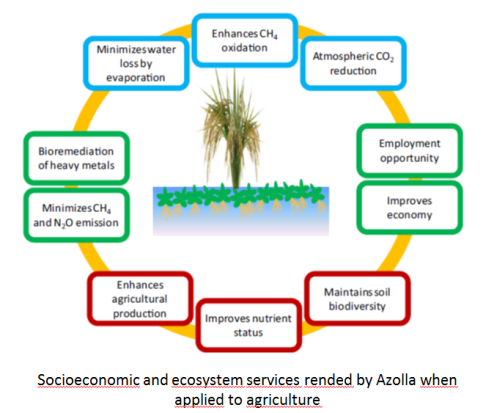Research area:
1) A multidisciplinary approach to gain sustainable improvement of rice productivity through the co-cultivation with the fern Azolla and its cyanobacterial symbiont
Achieving a steady increase in cereal crop yield has become a top research priority. The increment of world population, expected to reach 10 billion by 2050, coupled to food shortage, poses in fact a serious threat to social and political stability. Globally, food crop yields are already dangerously stagnating, indicating that further yield gains through conventional breeding and increased use of soil fertilizers are strategies that are not more pursuable. Further to this, enhanced plant productivity has to be achieved while preventing extensive land-use increase, deforestation, biodiversity loss, and environmental pollution. Therefore, urgent alternative and sustainable strategies to keep yield improvement in pace with world-wide population growth is mandatory. This multidisciplinary research proposal focuses on sustainable yield increase in rice grain production through the co-cultivation with Azolla-Anabaena. Rice (Oryza sativa) is both a model grass species and the world’s second-most produced staple cereal crop. Azolla is an aquatic pteridophyte that has coevolved with Anabaena azollae, a symbiotic nitrogen fixing cyanobacteria inhabiting the fern leaflets. In Asia Azolla co-cultivation with rice has been used for many centuries as an organic nitrogen fertilizer in wetland rice cultivation whereas in Europe its use is limited. The benefits of Azolla as a bio-fertilizer are well documented through decades of agronomic studies aimed at improving nitrogen use efficiency in rice. Beyond that, in virtue of their capacity to emit volatile organic compounds (BVOCs) and other signaling molecules (i.e hormones), the Azolla-Anabaena symbionts might positively interfere with rice plant development and resilience, thereby representing a potential natural resource to grow rice sustainably. Unfortunately, the nature of molecular interactions and the effects of the BVOCs emitted from Azolla-Anabaena on rice plants still remain unknown and unexplored.
The research project uses a multidisciplinary approach involving, physiological, molecular and genetic research to investigate the role of BVOCs emitted from Azolla-Anabaena in rice plant development, grain productivity and tolerance to environmental stresses. In particular, this project will first investigate in vivo the emission of BVOCs by Azolla-Anabaena both qualitatively and quantitatively. Then, the effects of the co-cultivation with Azolla-Anabaena on rice plant development (aerenchyma formation) will be investigated. To gain insight on how exogenous BVOCs exert beneficial effects on rice, the rice regulatory network controlling responses to BVOCs will be studied. Regulatory genes will be identified by transcriptome analysis using a next generation sequencing approach. Mutants for candidate genes will be obtained through a CRISPR-Cas9 genome editing approach or by overexpression analysis and functionally characterized upon application of specific exogenous BVOCs or co-cultivation with Azolla-Anabaena. The know-how generated in this project will create important opportunities for (molecular) breeding programs focused on rice germplasm that will fully exploit the beneficial effects of Azolla-Anabaena co-cultivation. In turn, this project will provide fundamental evidence on the interplay between crop plants and BVOCs emitted by other organisms being of pivotal importance for breeding and management of other crops. Importantly, this project is a beautiful showcase to demonstrate the valuable solutions for sustainable agriculture. On this concern, the achieved results will be disseminated to breeders, farmers and consumers.
This project is funded by the grant PRIN 2017 2017N5LBZK_004

2. Airborne pollen of olive meets carries and suffers air pollution
The linkage between pollen allergy and air pollutants was first reported at the end of the '80s but international research still talks about it today (Smiljanic et al., 2019). Allergic diseases, caused by pollen as well as by air pollution, are increasing and needs the definition of correct preventive measures. A crucial aspect is the lack of knowledge regarding the role and potential synergies of both pollen and air pollutants. The research attended to analyse the effect of air pollutants on the allergenic pollen of olive, particularly interesting for the widespread of this cultivation and especially for the most recent introduction of the olive in urban contexts as an ornamental tree. The study will be conducted in Umbria (Central Italy) during the 2019 pollen season. Three sites continuously monitored by Regional Agency of Environmental Protection (ARPA) and characterized by different quality pollution were chosen; i. Perugia, urban pollution from vehicular traffic; ii. Terni, emissions from the steel industry, iii. Monte Martano, regional background (EMEP site), as control.


